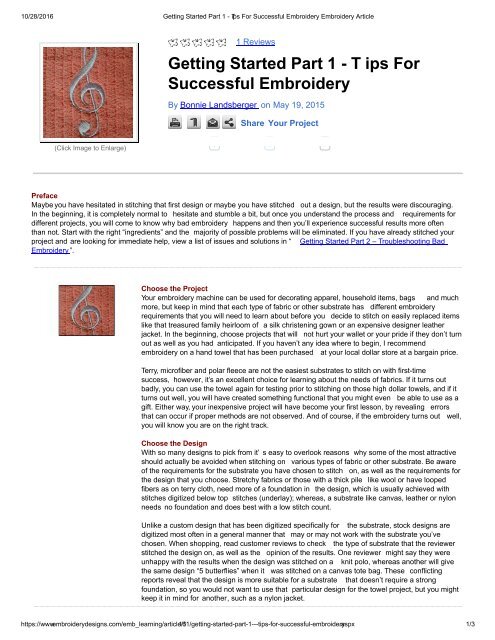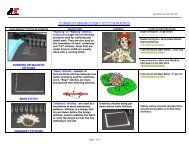Compiled Embroidery Skill Articles
Create successful ePaper yourself
Turn your PDF publications into a flip-book with our unique Google optimized e-Paper software.
10/28/2016 Getting Started Part 1 Tips For Successful <strong>Embroidery</strong> <strong>Embroidery</strong> Article<br />
1 Reviews<br />
Getting Started Part 1 T ips For<br />
Successful <strong>Embroidery</strong><br />
By Bonnie Landsberger on May 19, 2015<br />
Share Your Project<br />
(Click Image to Enlarge)<br />
0 0 0<br />
Preface<br />
Maybe you have hesitated in stitching that first design or maybe you have stitched out a design, but the results were discouraging.<br />
In the beginning, it is completely normal to hesitate and stumble a bit, but once you understand the process and requirements for<br />
different projects, you will come to know why bad embroidery happens and then you’ll experience successful results more often<br />
than not. Start with the right “ingredients” and the majority of possible problems will be eliminated. If you have already stitched your<br />
project and are looking for immediate help, view a list of issues and solutions in “ Getting Started Part 2 – Troubleshooting Bad<br />
<strong>Embroidery</strong> ”.<br />
Choose the Project<br />
Your embroidery machine can be used for decorating apparel, household items, bags and much<br />
more, but keep in mind that each type of fabric or other substrate has different embroidery<br />
requirements that you will need to learn about before you decide to stitch on easily replaced items<br />
like that treasured family heirloom of a silk christening gown or an expensive designer leather<br />
jacket. In the beginning, choose projects that will not hurt your wallet or your pride if they don’t turn<br />
out as well as you had anticipated. If you haven’t any idea where to begin, I recommend<br />
embroidery on a hand towel that has been purchased at your local dollar store at a bargain price.<br />
Terry, microfiber and polar fleece are not the easiest substrates to stitch on with firsttime<br />
success, however, it’s an excellent choice for learning about the needs of fabrics. If it turns out<br />
badly, you can use the towel again for testing prior to stitching on those high dollar towels, and if it<br />
turns out well, you will have created something functional that you might even be able to use as a<br />
gift. Either way, your inexpensive project will have become your first lesson, by revealing errors<br />
that can occur if proper methods are not observed. And of course, if the embroidery turns out well,<br />
you will know you are on the right track.<br />
Choose the Design<br />
With so many designs to pick from it’ s easy to overlook reasons why some of the most attractive<br />
should actually be avoided when stitching on various types of fabric or other substrate. Be aware<br />
of the requirements for the substrate you have chosen to stitch on, as well as the requirements for<br />
the design that you choose. Stretchy fabrics or those with a thick pile like wool or have looped<br />
fibers as on terry cloth, need more of a foundation in the design, which is usually achieved with<br />
stitches digitized below top stitches (underlay); whereas, a substrate like canvas, leather or nylon<br />
needs no foundation and does best with a low stitch count.<br />
Unlike a custom design that has been digitized specifically for the substrate, stock designs are<br />
digitized most often in a general manner that may or may not work with the substrate you’ve<br />
chosen. When shopping, read customer reviews to check the type of substrate that the reviewer<br />
stitched the design on, as well as the opinion of the results. One reviewer might say they were<br />
unhappy with the results when the design was stitched on a knit polo, whereas another will give<br />
the same design “5 butterflies” when it was stitched on a canvas tote bag. These conflicting<br />
reports reveal that the design is more suitable for a substrate that doesn’t require a strong<br />
foundation, so you would not want to use that particular design for the towel project, but you might<br />
keep it in mind for another, such as a nylon jacket.<br />
https://www.embroiderydesigns.com/emb_learning/article/1 161/gettingstartedpart1tipsforsuccessfulembroidery .aspx 1/3




